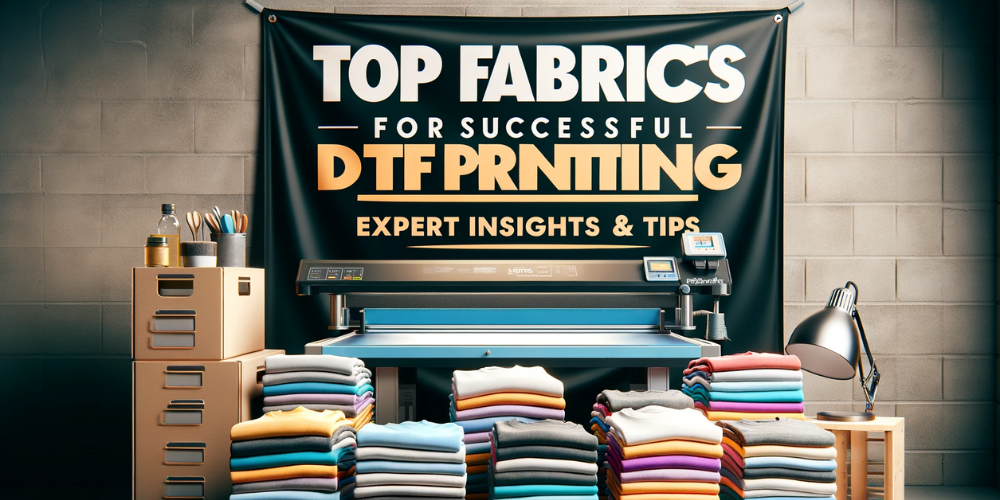DTF is the new hotness in textile game, changing how we think about printing on fabrics. This guide is all about why picking the right fabric is key to nailing high-quality DTF prints. Whether you're a pro printer or just getting started, getting the lowdown on DTF is a game changer.
What is DTF Printing?

So, what’s the deal with DTF? It's this awesome print method where your designs go onto a special film before making their way onto the fabric. It’s like the cooler cousin of Direct to Garment (DTG) printing – more colors and more fabric choices.
DTF’s process is simple but smart. First, print your design on the DTF films, put on some adhesive powder, and then heat press it onto your fabric. Boom – your design is on the tee! This method is different from screen printing, where you push ink through a screen onto fabric. Screen printing is great for big, simple jobs, but DTF? It’s perfect for detailed, colorful stuff, whether it’s a big order or just a few pieces.
Advantages of DTF Printing
Quality That Pops: DTF prints are crisp and vibrant. If your design has got details and colors for days, DTF has got you covered.
Mix It Up: From cotton to silk, leather to blends – DTF doesn’t play favorites. It works on a bunch of fabrics, unlike DTG that's all about cotton.
Tough Stuff: DTF prints are tough cookies. They stick around through washes and wear, keeping your designs looking fresh.
Big or Small, Print 'Em All: Got a huge order? OR Just a few pieces? DTF is flexible like that. No sweat either way.
Eco-Friendly Choice: DTF is cleaner and greener compared to traditional methods. Less waste, fewer chemicals – good for you and the planet.
Understanding Fabrics for DTF Printing

DTF printing isn't limited to just one type of fabric – it's versatile. But not all fabrics are created equal when it comes to this technology. Let’s break down what’s hot and what’s not:
Types of Fabrics Suitable for DTF Printing
- Natural Fabrics: Cotton, silk, and linen are top choices. They soak up DTF ink like a sponge, giving you those crisp, eye-popping prints.
- Synthetic Fabrics: Fabrics like polyester, nylon, and spandex are also compatible with DTF printing. They offer unique benefits, like durability and stretch, but may require specific handling.
- Blended Fabrics: These fabrics combine the qualities of natural and synthetic fibers, offering a balance of comfort, durability, and printability.
Characteristics of Ideal Fabrics for DTF Prints
The dream fabric for DTF should be:
- Ink-Friendly: This ensures that the print is vibrant and long-lasting.
- Heat-Proof: Essential for the heat pressing stage of DTF printing.
- Smooth Texture: A smoother surface results in clearer and more detailed prints.
- Stable Color: Lighter-colored fabrics typically work better, as they don’t alter the ink colors.
Best Fabrics for DTF Printing

Let’s get into the nitty-gritty of some fabric superstars:
COTTON: Characteristics and Why It's Suitable
Cotton is a star in the DTF printing world. It’s highly absorbent, which means it takes to DTF ink like a fish to water. Its softness and comfort make it a popular choice for everyday wear, from T-shirts to tote bags.
POLYSTER: Benefits for DTF and Potential Challenges
Polyester’s strength and color retention make it ideal for DTF printing, especially for sportswear and outdoor gear. It keeps the colors vivid for ages but watch out when you turn up the heat – it can get a bit fussy.
BLENDS: How Mixed Fabrics React to DTF Prints
Blends, like cotton-polyester, leverage the benefits of both fibers. They offer a middle ground in terms of ink absorption and durability, suitable for a wide range of applications.
SPECIALITY FABRICS: Unique or Less Common Options
Exploring unique options like denim, canvas, or even specialty athletic fabrics can open new avenues for creative DTF printing projects. These fabrics can add a distinct look and feel to your prints.
Preparing Fabrics for DTF Printing

Getting your fabric ready is key to achieving high-quality DTF prints. Here’s how you can prep different fabrics:
Pre-treatment Processes for Different Fabrics
- Pre-treating Cotton: Involves applying a base layer to enhance ink absorption.
- Preparing Polyester: Requires careful heat setting to avoid shrinkage or melting.
- Handling Blends: Blends might need a combination of cotton and polyester pre-treatment methods.
Tips for Ensuring Fabric is Ready for DTF Printing
- Test it Out: Always run a small test print to check for ink absorption and color accuracy.
- Fabric Quality: Opt for high-quality, tightly woven fabrics for the best results.
- Keep it Clean: Dirt and wrinkles are print killers. Keep your fabric spotless.
- Moisture Content: Pre-heat the fabric to remove any moisture, which can affect print quality.
DTF Printing Process

Step-by-Step Guide on the DTF Printing Process
Design Creation: It all with a digital design, created using graphic design software. Don't forget to explore our online gang sheet builder, where you can design and print multiple patterns on a single sheet. This design is key to your final print's look.
Printing the Design on Film: The design is then printed onto a special DTF transfer film. This step is crucial for detail and color accuracy.
Applying Powder Adhesive: After printing, a powdered adhesive is evenly spread over the design. It’s this adhesive that bonds the ink to the fabric.
Curing the Adhesive: The film with the adhesive is then cured, typically using a heat press. This process melts the adhesive without damaging the film.
Transferring to Fabric: The film is placed onto the fabric, and heat and pressure are applied. The heat causes the adhesive to bond the design onto the fabric.
Final Curing: After removal from the heat press, the fabric goes through a final curing to ensure the print's durability
Cooling and Peeling: Once cooled, the film is peeled off, leaving the print on the fabric.
Read our detailed guide on DTF printing process
Highlighting the Role of Fabric in Each Step
Design Printing: The choice of fabric can influence the ink absorption and color representation in this step.
Adhesive Application: Different fabrics react differently to the adhesive; for instance, thicker fabrics may require more adhesive.
Heat Pressing: Temperature and time settings can vary based on the fabric's heat sensitivity.
Future of DTF Printing and Fabric Innovation

Let’s explore the emerging trends in fabric and DTF technology and make some educated guesses about what the future holds.
Emerging Trends in Fabric and DTF Technology
Sustainable Solutions: The future is green, and DTF printing is no exception. Eco-friendly inks and sustainable practices are becoming more prevalent, reducing the environmental impact of fabric printing.
Enhanced Fabric Compatibility: The quest to broaden the range of fabrics suitable for DTF printing is ongoing. Expect advancements that allow even more types of fabrics to be compatible with DTF printing techniques.
Improved Print Durability: Research is focusing on making DTF prints more resistant to wear and tear, ensuring that they last longer even with regular use and washing.
Increased Efficiency: Future DTF printers are likely to be faster and more energy-efficient, offering higher productivity without sacrificing quality
Broader Color Spectrum: Color technology is evolving, promising a future where DTF prints feature even more vibrant and diverse color ranges.
Predictions for the Evolution of DTF Printing
Artificial Intelligence and Automation: The integration of AI into DTF printing processes is expected, leading to more precise and consistent print quality with minimal human intervention.
Customization at Scale: The ability to produce customized prints quickly and efficiently is likely to become a standard feature, catering to the growing demand for personalized fabric products.
All-in-One DTF Solutions: We might see the development of comprehensive DTF systems that streamline the entire printing process, from design to final print.
Conclusion
DTF printing is a total game-changer in the fabric printing scene, opening up a world of creative and innovative possibilities. Get the lowdown on the right fabrics and prep them just right, and you’re set for some seriously impressive prints that not only look awesome but last ages too. Dive into the versatility of DTF transfers and take your textile projects to the next level!
Frequently Asked Questions
Can DTF printing be used on any fabric?
While DTF is versatile, it works best on certain fabrics like cotton, polyester, and blends. However, advancements are being made to expand its compatibility with more fabric types.
How long do DTF prints typically last?
DTF prints can last a long time, often several years, with proper care. The key is following specific washing and maintenance instructions.
Is DTF printing environmentally friendly?
The DTF industry is moving towards more eco-friendly practices, including the use of sustainable inks and processes that reduce waste and energy consumption.
Can I do DTF printing at home?
Yes, with the right equipment and setup, DTF printing can be done at home. It's important to have a suitable space and follow safety guidelines.

